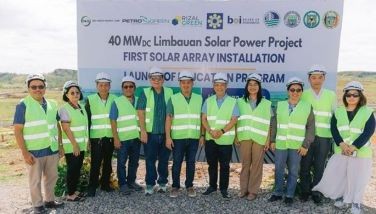Devalued property

Think about it: if a reclamation project blocks natural water passageways and causes regular massive flooding in your community, what happens to economic activities and the value of properties in the area?
The economy will tank, and property values all over will plummet. Owners will be hard-pressed to find buyers for their much devalued property.
Take it from someone whose family has made billions from property development. Sen. Cynthia Villar says her serious concern about flooding in her home turf of Las Piñas led to her battle against the Manila Bay reclamation near the city’s shores.
The reclamation was initiated during the Ramos administration by Amari Coastal Bay Development Corp. through a deal with the Public Estates Authority (PEA), forerunner of the Philippine Reclamation Authority (PRA).
In 2002, upon the petition of then solicitor general Francisco Chavez, the Supreme Court nullified the sale of a 368-hectare property to Amari by the PEA.
Today the property in question along the Las Piñas-Parañaque coastal area is a lush ecotourism park – an officially designated protected wetland of international importance. The mangrove forest is home to numerous species of birds and serves as a marine sanctuary.
The 175-hectare wetland park is jointly administered by the Department of Environment and Natural Resources (DENR), Tourism Infrastructure and Enterprise Zone Authority, Villar SIPAG and the Society for the Conservation of Philippine Wetlands.
* * *
On “The Chiefs” on Cignal TV’s One News, where she became our first guest in our reformatted edition over the weekend, Villar was asked about the explanation of some local government officials for allowing massive reclamation projects in their sectors of Manila Bay.
The officials said the expanded land area would mean more business and livelihood activities for their cities, meaning more revenues and economic advancement.
Villar said the objective is fine, but the long-term destructive impact of the reclamation on the original land area cannot be ignored.
In Las Piñas, she said property values have risen by about tenfold in the past two decades. This could not have been possible, she said, if the Amari reclamation project had proceeded and blocked the four city waterways that open out into Manila Bay, causing massive flooding.
It’s not just the communities inland that must contend with the environmental impact, but also people who make a living from the sea.
That area of Cavite from Kawit to Tanza, Noveleta and Cavite City should have been developed into a traditional fishing community, with numerous heritage sites beginning with the Aguinaldo shrine.
Instead massive reclamation projects may soon obliterate the fishing industry in those areas, and even the few beach resorts that have survived may soon be out of business.
I go to those coastal areas regularly to buy fresh shrimp and prawns, oysters, mussels and the best tuyo (not salty) and other dried fish. At the pace of reclamation activities, I’m afraid these livelihoods will soon vanish, like the sea view from Roxas Boulevard.
* * *
Some reports have pointed out that each bay reclamation project was assessed for individual environmental impact, when the cumulative effects of multiple reclamations on the bay ecological system should have been considered.
The cumulative assessment should have been possible because all the 22 reclamation projects in question were approved within just three years of the Duterte administration, starting after the PRA was placed under the Office of the President on Feb. 1, 2019.
The PRA clarified that only 13 projects are in Manila Bay. The DENR corrected this and said there are 15 in the bay affecting Metro Manila and seven affecting Region 4-A or Calabarzon (Cavite, Batangas, Laguna, Rizal and Quezon).
Whether it’s 13 or 15, you’ve seen the ugly images of the reclamation work. As President Marcos put it, the sea has disappeared from Roxas Boulevard.
While everyone was distracted with the drastic cleanup of Boracay, the greater environmental threat was being laid down in Manila Bay.
Alongside the bay projects, rapid and massive reclamation activities were also undertaken and are still ongoing in Laguna de Bay, notably along the C-6 road running from Taguig to Taytay, Rizal.
The lake, already heavily silted from too many fishpens, is tapped to augment potable water sources in Metro Manila. The DENR may want to include those lake reclamation activities in its review.
DENR Secretary Antonia Yulo-Loyzaga is in an unenviable position, with tremendous pressure being exerted by powerful interests.
The most entertaining defense of the suspended projects is the mental acrobatics on what constitutes reclamation, and why we should even thank a proponent as our savior from flooding.
* * *
Villar’s family businesses have also encountered controversy over land use, and the conversion of agricultural lands into mixed-use property development.
She explained to The Chiefs that her family develops property only in cities or capital towns. It’s simply a business strategy, she said.
“Usually the developers don’t build houses in the farmlands. Nobody will buy in the farmlands,” she told us. “We only build in the cities. Who will buy homes in the farmlands?”
She acknowledges that even in cities, there may be areas classified as agrarian lands. But she points out that in cities, private owners are allowed to sell these lands for conversion to mixed-use property development. The sellers, she says, can then buy bigger lands for farming outside the city.
Such conversions of agricultural lands must be limited to cities, Villar said. She asked: “What’s wrong with developing cities and keeping agriculture outside cities?”
She said the key is to make agriculture more competitive, through technology and improved farming methods that boost production.
One problem here is that more and more towns are being reclassified as cities. This situation may be addressed by the Land Use Act, whose House version has been passed on third and final reading this year.
The Villar Group does not buy land where it can’t sell houses, Villar stressed. She pointed out that people also consider the resale value when they buy houses, and it’s tough to sell houses outside cities.
“It’s a law of supply and demand,” Villar told us. “You will not buy (a house) if you cannot resell it.”
And people won’t buy property in a place known for flooding. She says this is a long-term consequence of massive bay reclamation activities that local governments may want to consider.
- Latest
- Trending























